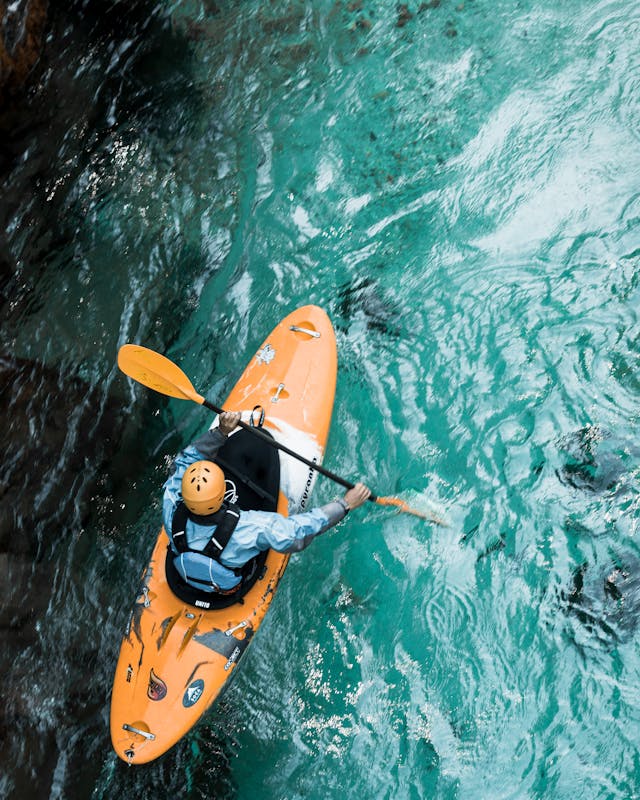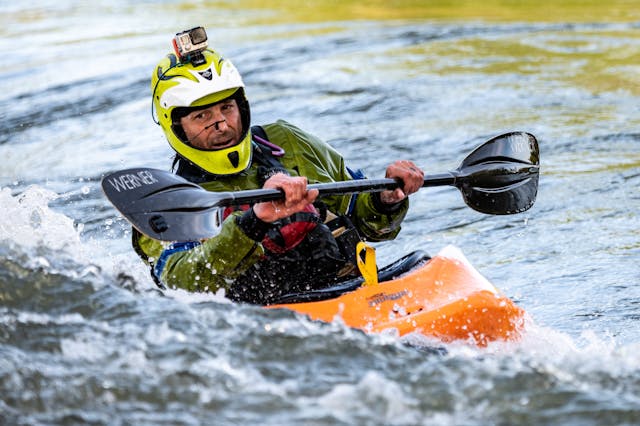Mastering the kayak draw stroke is essential for any kayaker who wants to maneuver their kayak sideways with precision and ease. This stroke is handy when you need to move your kayak sideways without turning it, such as when approaching a dock or another kayak. It’s a skill that can elevate your kayaking experience and make you feel more in control on the water.

The draw stroke, sometimes called the “pulling” stroke, involves placing the paddle in the water off your hip and drawing the kayak toward the blade. This action can seem tricky at first, but with practice, it becomes a natural and powerful technique. It’s vital to practice this stroke regularly, as it requires coordination and timing to execute smoothly.
We’ll break down the basics of the draw stroke, including common techniques and advanced applications. Knowing how to properly execute this maneuver will give you greater confidence in your kayaking adventures. Let’s dive into the mechanics and benefits of the draw stroke, ensuring you’re well-prepared for your next paddling trip.
Key Takeaways
- Kayak draw stroke moves the kayak sideways effectively
- Practicing the technique builds control and maneuverability
- We cover basic to advanced applications for various scenarios
Basics of Kayak Draw Stroke
The kayak draw stroke is a crucial skill for effective maneuvering. Learning this technique helps in moving the kayak sideways and is essential for better control and navigation.
Understanding the Draw Stroke
The draw stroke moves your kayak sideways without changing its direction. Start by placing the paddle blade in the water at your hip, about two or three blade lengths away from the kayak. Keep the power face towards you and rotate your torso towards the direction you want to move.
Use loose fingers on the top hand to help guide the paddle through the water smoothly. Pull the kayak towards the paddle blade, making sure to drop the top hand at the exit. This technique includes a catch, propulsion, and recovery phase. Keep your strokes consistent for a smooth glide.
Importance in Maneuvering
Mastering the draw stroke is essential for precise movements in tight spaces. It’s particularly useful for docking, avoiding obstacles, or positioning for fishing. The ability to move sideways without turning the kayak gives you much more control.
This stroke allows for parallel parking your kayak, crucial during rescues or group paddling. It also helps in windy conditions by giving you better control over your path. Practicing this stroke will make your paddling experience more fluid and enjoyable.
Executing the Draw Stroke

The draw stroke helps move your kayak sideways without changing its direction. Proper positioning and technique are crucial for success.
Positioning and Grip
To start, you should position yourself comfortably in your kayak. Sit up straight and keep your core engaged. This stance helps maintain balance and control. Rotate your upper body toward the direction you want to move.
Grip is also important. Place the paddle blade in the water at your hip, with the power face toward you. Hold the paddle shaft with loose fingers on the top hand, allowing for ease of movement. Your top hand should be at about eye level, and the shaft hand should remain low. Keep the paddle blade vertical and perpendicular to the kayak for the best results.
The Catch Phase
The catch phase involves placing the paddle blade into the water. Start by reaching out a couple of blade lengths away from the kayak, parallel to the water’s surface. The paddle blade should enter the water smoothly, so avoid any splashing.
As you draw the paddle toward your kayak, use your shaft hand to guide the movement. Your top hand should stay loose, aiding in a smooth, controlled motion. The end of the stroke, called the recovery, involves lifting the blade out of the water and repeating the steps. Practicing this technique will enhance your control and efficiency in maneuvering your kayak.
Common Draw Stroke Techniques
Draw strokes are essential for moving your kayak sideways and for precise maneuvering. Here’s a breakdown of three important techniques: the sculling draw stroke, the forward and reverse draw, and integrating a sweep stroke.
Sculling Draw Stroke
The sculling draw stroke is about moving the kayak sideways smoothly. We position the paddle blade in the water parallel to the kayak. By moving the blade back and forth in a figure-eight pattern, we pull water under the kayak.
For a good sculling draw, angle the blade slightly towards the boat. Keep your movements slow and controlled. This stroke is great for small adjustments and maintaining stability. It’s often used in narrow spaces where turning isn’t practical. Practicing this stroke improves balance and control.
Forward and Reverse Draw
The forward draw stroke involves placing the paddle in the water close to the bow and pulling it towards the stern. This helps slide the kayak sideways towards the paddle. When doing a reverse draw stroke, we start near the stern and push the blade forward.
Keep your movements smooth and fluid. For better reach, twist your torso instead of just using your arms. These strokes are useful for docking alongside another kayak or making precise turns without moving forward or backward much.
Sweep Stroke Integration
Combining the sweep stroke with the draw stroke can make us more efficient. Start with a sweep stroke to turn the kayak towards the desired direction. Follow with a draw stroke to slide the kayak sideways.
This technique helps in situations where we need to reposition quickly. A sweep stroke covers more distance and adds momentum, while the draw stroke fine-tunes our position. Mastering this combination makes tight spot navigation easy.
Advanced Applications and Safety
Using the kayak draw stroke in challenging environments requires skill and caution. Proper techniques help with navigating obstacles and prevent capsizing.
Navigating Obstacles and Rapids
When kayaking through rapids like Rapid III or Rapid IV, precision is key. By using the draw stroke, we can position our kayak to avoid rocks and other hazards. A good body position helps maintain control and momentum. Lean forward slightly and keep your strokes smooth.
For those into whitewater kayaking, draw strokes help move laterally without losing forward speed. In difficult passages, positioning can be the difference between smoothly navigating and hitting an obstacle. Experienced kayakers use the bow draw and stern draw strokes to steer effectively, even in turbulent waters.
Preventing Capsize
Capsizing is a concern in any kayaking scenario. Using the draw stroke properly can help prevent this. Keep our body centered and paddle movements controlled. In rough waters, this balance is vital.
Practicing the low brace and high brace turns can enhance stability. These techniques help in regaining control if our kayak tilts. Senior editors from Kayak Manual recommend learning these strokes to improve safety. Always practice in calm waters before attempting in challenging conditions. Even with advanced skills, kayaking with a friend enhances safety and enjoyment.
Frequently Asked Questions
Understanding the kayak draw stroke is key for moving sideways, improving control, and mastering various paddle techniques. These FAQs address common questions to help you navigate waters better.
Q: What are the steps for performing a successful kayak draw stroke?
A: To perform a successful draw stroke, place the paddle at your hip, then draw the kayak towards the blade. Keep fingers loose on the top hand for better control. Rotate your upper body as you make your stroke. This is detailed more on Paddling.com.
Q: How does the cross draw stroke differ from the standard draw stroke in kayaking?
A: In a cross draw stroke, you reach across your kayak and place the paddle on the opposite side. This technique is helpful for quick turns. The standard draw stroke is done on the same side you are sitting on. More on differing strokes can be explored at Kayak Angler.
Q: Can you list the key kayak strokes essential for maneuvering effectively?
A: Key strokes include the forward stroke, reverse stroke, draw stroke, and sweep stroke. Each of these helps in various situations like moving in a straight line, pivoting, or side-stepping. Learning these basics forms a strong foundation for effective kayaking maneuvering.
Q: What techniques should beginners learn to effectively paddle a kayak?
A: Beginners should start with forward and reverse strokes, the draw stroke, and sweep stroke. It’s also crucial to learn how to hold the paddle properly and maintain a good posture. Practicing these basic strokes will help in building confidence and control.
Q: In what situations is a stern draw stroke most effectively used while kayaking?
A: The stern draw stroke is best for steering the back of the kayak. It’s particularly effective when making tight turns or adjusting direction while moving quickly. This stroke is easier to perform when you need to fine-tune your path without losing speed.
Q: How can one progress from basic to advanced kayak paddling techniques?
A: To move from basic to advanced techniques, practice consistently and push your limits safely. Join a kayaking group, take more advanced classes, and maybe get into whitewater kayaking or sea kayaking for more challenging experiences. Keeping up with new skills is key.
By tackling these questions, we get clearer on how to improve and enjoy kayaking. There’s always something new to learn, making this sport exciting and rewarding.


3 thoughts on “Kayak Draw Stroke: Mastering Agile Direction Control”